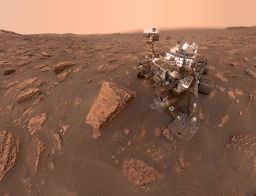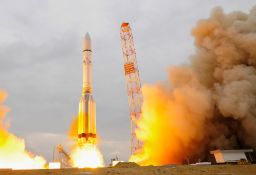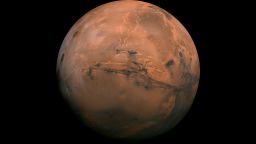For decades, space was the final frontier. But as space exploration advanced, scientists increasingly set their sights on a new frontier: Mars.
The first lander to reach Mars was launched nearly 50 years ago, but much about the red planet remains a mystery. Scientists are still attempting to bring samples of Mars’ red soil back to Earth for further study, and human trips to Mars are still years from being feasible.
After decades of roving, research, and taking illuminating photos of the red planet, the biggest question remains: Could there be life on Mars?
Breakdown of a planet
To understand Mars’ potential for life, we need to go back in time about 3 or 4 billion years.
At that time, Mars and Earth shared many of the same characteristics. The red planet was warm and wet, with a robust atmosphere – a far cry from the cold, unforgiving place it is today.
“Mars is a planet that started with all the same raw materials as Earth, but along the way has suffered changes,” said the European Space Agency’s Director of Human and Robotic Exploration, David Parker. “You could say it’s kind of broken down.”
Because it was once Earth’s sister planet, Parker said scientists must ask themselves, “When life got going on Earth, did it get going on Mars?”
Mars lost its magnetic field, meaning nothing shields the planet (or potential life forms) from radiation. Mars also lost most of its atmosphere – another deviation from Earth, where the atmosphere supports life by giving us oxygen and acting as a blanket for the planet.
“Mars still has an atmosphere but it’s very thin and mostly carbon dioxide, so it’s colder,” explained Parker.
That means the average temperature on Mars is -81 degrees Fahrenheit, which makes it an unforgiving planet for most life forms.
Signs of life
But just because Mars is cold and unprotected doesn’t mean scientists have ruled out finding life.
In 2018, NASA’s Curiosity rover found organic matter on Mars, which could mean that the building blocks for life once existed, or still exist, on Mars.

“Organic matter preservation is central to understanding biological potential on Mars through time,” wrote NASA researchers in the journal Science. “Whether it holds a record of ancient life, is the food for extant life, or has existed in the absence of life, organic matter in martianmaterials holds chemical clues to planetary conditions and processes.”
NASA’s rover has also detected methane on Mars, which is considered the most simple organic molecule and could be another chemical clue of life.
“With our current measurements, we have no way of telling if the methane source is biology or geology, or even ancient or modern,” said Paul Mahaffy, director for NASA Goddard’s Solar System Exploration Division, in a June press release.
Meanwhile, Europe and Russia’s ExoMars Trace Gas Orbiter launched in 2016 with the aim of detecting atmospheric gases that could mean there’s active, biological life on Mars. The ESA’s Parker said that while the Curiosity Rover found methane on parts of the surface, they have not detected methane all across Mars’ atmosphere.

“We have not seen methane globally on Mars, which means methane gas is being produced somehow,” Parker said. “So is there a methane cycle on Mars?”
The discovery of localized methane presents an exciting breakthrough because a common source of methane on Earth is microbial life, according to NASA.
Water is key
Water and ice on Mars also provide valuable clues that suggest Mars might be more habitable than once thought.
In 2015, NASA scientists thought they found evidence of occasional flowing, salty water flows across the surface of Mars. However, another NASA study in 2017 determined that the flows were most likely grains of sand and dust.
But another breakthrough came in 2018 when the European Space Agency detected a small lake of liquid water beneath the southern polar ice cap of Mars, which the ESA said could further contribute to knowledge about Mars’ evolution and habitability.
And this year, NASA’s Curiosity rover found evidence in Mars’ Gale Crater that there were once ancient salty lakes on the surface – another hint that the red planet could have once supported microbial life.
“Water is key because almost everywhere we find water on Earth, we find life,” wrote NASA on their website.
It’s not just liquid water that space scientists are interested in, but also ice. Parker said the ESA is currently working on research about the ice below Mars’ surface.
“We’re getting more and more information about subsurface water ice … it’s further from the poles thanwe thought,” Parker told CNN.
Ice could be further evidence of habitable conditions, and it could also be a valuable resource if space agencies send humans to Mars one day.
Human missions to Mars?
To unravel the more complex mysteries surrounding life on Mars, scientists want to collect samples, which would require a round-trip mission.
“Because the really powerful scientific instruments are huge, we can’t take them and never will be able to take them to Mars. So we need to bring Mars back to Earth,” Parker said. “By bringing Mars back, we can study it for the next 50 years.”

Although no space agency has yet figured out how to launch an unmanned craft from the surface of Mars to get samples back to Earth, one way to bring back Martian samples would be for astronauts and cosmonauts to collect them in person.
But reaching Mars, which at its closest point is still about 33.9 million miles away from Earth, would be a feat of engineering.
“It’s is an order of magnitude farther away. You’re talking about a 3-year round-trip mission,” said NASA spokeswoman Stephanie Schierholz.
If reaching the Moon was one giant leap for mankind, reaching Mars would be more like an Olympic long jump. And unlike traveling to the International Space Station (a mere 250 miles above Earth), traveling to Mars would potentially require a lot more packing.
“We send up resupply missions every few months (to the space station),” Schierholz said. “We don’t have the luxury of doing that if we go to Mars.”
Despite the challenges, NASA is aiming to send astronauts to Mars by 2035. That means the firstlife on Mars could be us.



























